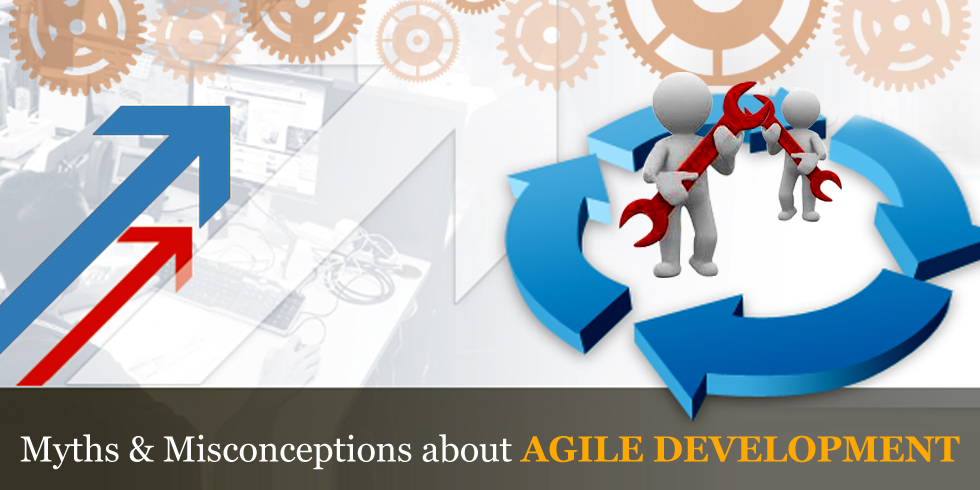Are you SURE you are not Misunderstanding Agile Development?
Agile is a well-known methodology for custom software development. Agile model offers a flexible framework, ensuring rapid delivery of business value. It supports changes effectively, which other traditional software development methods do not. However there are still many businesses who haven’t heard about Agile or aren’t fully aware about it.
There are many misconceptions surrounding Agile. A lot of questions come up several times demonstrating the myths that people have about it. Through this post we have tried clearing some major misunderstandings about Agile Development, to make you fully aware about this model and help you take a wise decision on choosing the right project development methodology for your business!
- The most common misconception is, that ‘Agile methodology doesn’t involve planning’. Planning in an ongoing process in Agile which is done at the project outset in Waterfall methodology. Agile teams do not require big up-front planning. This approach to planning is to adapt rapidly to the changes as the project progresses.
- Many businesses think that ‘Agile lacks proper management’. This myth is because of its principles of favoring the response to changes. In other methods, a lot of meetings, reporting and control are involved. Developers thus fail to utilize full time in the development process. Agile method removes the involvement of an architect and gives full freedom to developers to carry on their tasks. But this doesn’t hold true for all the projects; Agile involves higher authorities in case of large-scale or challenging projects. This not only results in successful execution of the project but also doesn’t break any Agile principle or deviate from the desired outcome.
- One more myth is, that ‘Agile has no documentation’, which doesn’t hold true. You can have as much documentation as you like; if it is useful and brings you value. As documentation provides a road map to the development process, increases collaboration and gives a better understanding of the entire process, Agile compiles the user stories instead of a single, lengthy document with all the project requirements.
- That ‘Agile leads to a chaos’, is another misconception, as many businesses are not used to the iterative nature of this method. Agile gives the flexibility to change the requirements as per the changing market conditions but that doesn’t mean that the development process is disorganized. The team can undertake long-term planning; businesses just need to know where to apply Agile Development.
- Many businesses consider ‘Agile an unscalable model’. But the scalability of project actually depends on the scope of the project and the number of people involved in it. Larger the project’s scope, greater are the chances of failure and scaling issues. Agile development breaks a single big project into smaller ones, staffed by smaller teams. This makes the management of the project easier, reduces the chances of errors and ensures more productivity.
- Many companies believe that ‘Agile will not last long’. They think that Agile has been hyped and is just another fad. Since the last few years, many tech giants have adopted Agile. Businesses and enterprises have found that by going the Agile way, they are able to quicken time-to-market, improve the quality of their offerings and align business and market needs with IT. The growing preference of Agile model shows that it is here to stay!
- Businesses think that ‘Agile overlooks quality’, which is definitely a myth. In fact Agile practices are diverted towards improving the quality and fixing the defects in early stages. Agile ensures there are lesser bugs; errors are fixed quickly before they become unmanageable and the end-product is sustainable.
- Another misconception says, ‘Agile method is only for software development’. No doubt, Agile model evolved in software development, but the core principles of Agile support other development projects as well.
- There is also a myth that ‘an uncertainty element is involved in Agile until development is complete’. In Waterfall method, requirements are well-defined, before the development starts. Agile is preferred when unanticipated changes are to be incorporated, which can otherwise result in costly delays. This approach provides a better understanding of what can be expected in the near as well as long term.
It is important for a business to be clear about these misunderstandings, to adopt the right project development methodology for getting the desired outcome. For some businesses, Agile method may not be suitable, but this decision should be taken based on the facts rather than the myths highlighted in the post!
Semaphore Software is a leading custom software development company, specializing in Agile development methodology and helping businesses in successful completion of their projects.
Get in touch with us through info@semaphore-software.com to connect to our experienced developers, delivering high-quality custom solutions!!


